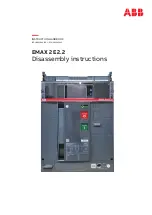
25
Instruction Book
IB182017EN February 2017 www.eaton.com
5kV, 7.5kV, & 15kV DHP-VR
Replacement Circuit Breaker
4.7.1 BREAKER-CELL CODING PLATES
This is a combination of a notched plate in the cell and interference
bars on the breaker, so that only appropriately rated breakers can be
put into the cell (Figure 4.7 and Figure 4.8).
4.7.2 RACKING-IN INTERLOCK
The racking-in interlock is designed to prevent moving the breaker
into or out of the Operating position, if the breaker contacts are
closed. DHP-VR interlocks are completely compatible with the
existing racking screw located in the existing DHP or DVP assembly
structure.
DHP-VR 5kV breakers utilize a racking-in interlock design that is very
similar to the design used on DHP breakers. A key, which is spring
operated by the closing and opening action of the breaker, prevents
racking of the breaker, unless the breaker is open. Opening the
breaker removes the key from the racking-in shaft key-way, and the
breaker can be racked.
DHP-VR 7.5 and 15kV breakers utilize a device that also prevents
racking a breaker with the contacts closed, but is different in design
from the 5kV breaker. It consists of a plate supported by a pin
between the two pole shaft levers. As the breaker closes, the plate
falls into the racking-in shaft keyway, by virtue of gravity. Opening
the breaker lifts the plate out of the keyway, and the breaker can be
racked.
4.7.3 ANTI-CLOSE INTERLOCK
The anti-close interlock prevents discharging of the closing springs
if the breaker is already closed (Figure 4.15, Item 11). When the
breaker is closed, the interlock component moves away from the
spring release clapper so that it cannot lift the spring release latch
(9).
4.7.4 FLOOR TRIPPING AND CLOSING SPRING RELEASE
INTERLOCKS
The floor tripping and closing spring release interlocks operate to
trip the breaker and discharge the closing spring when the breaker
is inserted into the cell to the test position, or removed from the
cell. Cam plates on the cell floor lift trip levers on the underside of
the breaker to trip the breaker and/or discharge the closing springs
(Figures 4.9 and 4.11).
The floor tripping interlock also operates to hold the breaker trip-free
while it is traveling between the Test and Connected positions. This
is to prevent accidental closing of the breaker in an intermediate
position.
4.7.5 RAIL LATCH
The main function of the rail latch is to prevent damage to the
racking-in screw and nut. It also functions to latch the breaker in the
Test position, as described in the Inspection and Installation Section
of this manual (Figure 4.10 and Figure 4.12).
WARNING
DO NOT FORCE THE BREAKER INTO THE CELL. DOING SO MAY DAMAGE
PARTS THEREBY RISKING DEATH, PERSONAL INJURY, AND/OR PROPERTY
DAMAGE.
4.8 MISCELLANEOUS ITEMS
4.8.1 GROUNDING CONTACT
The grounding contact is an assembly of spring loaded fingers which
ground the breaker frame (static ground) by engaging the switchgear
cell grounding bus when the breaker is racked into the cell. The
ground contact is located at the rear of the breaker near the floor
and visible from the back of the breaker when out of the cell.
Figurt 4.9. 5kV Floor Tripping Ltvtrs (Undtrntath Front Vitw)
Figurt 4.11. 15kV Floor Tripping Ltvtrs (Undtrntath Rtar Vitw)
Figurt 4.10. 5kV Rail Latch
Figurt 4.12. 15kV Rail Latch









































